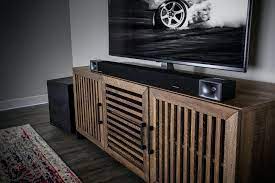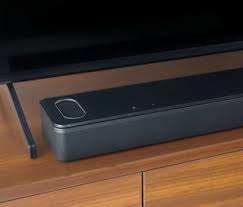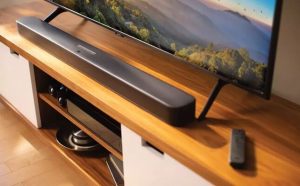Are you ready to take your TV’s sound up a notch? When you buy a flat-screen TV, no matter how good the picture quality is, if you rely on the built-in speakers, the sound quality will not be very good. Soundbars and sound bases are a low-cost way to improve sound, but opinions differ on which is better and why.
 Soundbars and sound bases differ in design, sound, and placement. Soundbars are long and narrow, usually with several built-in speakers and often an external subwoofer. Soundbases are compact, can be placed under the TV, and feature a larger number of built-in speakers.
Soundbars and sound bases differ in design, sound, and placement. Soundbars are long and narrow, usually with several built-in speakers and often an external subwoofer. Soundbases are compact, can be placed under the TV, and feature a larger number of built-in speakers.
When choosing between the two, it is important to see all the differences and know exactly what each offers. First, understand what these devices are and then compare them.
Soundbase vs Soundbar |
Table of Contents
What is a sound base?
A sound base is a compact speaker box on which the TV sits. Sound bases are designed to provide higher sound quality than the TV’s built-in speakers, yet are economical and very easy to install.
Advantages
- Sound bases are large and bulky and require space for larger, more powerful speakers. There is room for speakers and a subwoofer, so external speakers would not be necessary if not needed. If you want high-quality sound on your flat-panel TV in a single component, the Soundbase is the perfect choice.
- Although not as small as a soundbar, the Soundbase is compact enough to be placed under the TV without obstructing its view. Rather, they become an extension of the TV.
Disadvantages
- Soundbase can only be placed on top of furniture. This means that it cannot be mounted. If a TV is already mounted, the sound base may not be suitable due to the mounting options required. They are also larger and heavier than soundbars.
- Sound bases are less popular than soundbars, so there are fewer options. They tend to be more expensive because there are fewer manufacturers. They are also less likely to have smart features such as voice assistants.
- Soundbases have fewer forward-facing speakers than soundbars, so they cannot bounce sound around and fill a room like a good soundbar can.
 What is a soundbar?
What is a soundbar?
Soundbars are long, slender speaker systems that are also designed to improve the poor sound quality of flat-panel TVs. They are also reasonably priced and nowadays, especially in packages that include external speakers, sound quality is becoming closer to that of traditional surround sound systems.
Advantages
- With the growing popularity of soundbars in recent years, they are better designed than ever. The quality of the speakers has also improved, and the technology inside is remarkable. In addition, many additional features have been added for added convenience.
- Soundbars are designed for ease of use and offer many features and smart technology integration; from compatibility with smart home devices such as Amazon Alexa and Google Home, to Bluetooth and more, you will be impressed with the types of integration you will find with soundbars.
- Soundbars are a more popular option than soundbases, so there are many choices, prices, and packages on the market. With a wider selection, you are sure to find the perfect solution for you and your needs.
- Finally, soundbars look good. Since they are often placed in the main living room, they are designed to look good in the room’s interior.
Disadvantages
Soundbars are becoming thinner and narrower, requiring less space inside the cabinet. Compact speakers have limited sound power, so they are often combined with external speakers.
Therefore, the simplicity that is the main characteristic of soundbars is made more complex by external speakers that require power connections and unique placement. Nevertheless, there are also soundbars with built-in subwoofers, such as the one introduced here.
Because of this wide variety, the market is actually flooded with very inexpensive options, and it can be easy to get ripped off if you purchase a soundbar thinking you are getting a good deal. However, this only affects the lower-priced options.
What is the difference between a soundbase and a soundbar?
Soundbases and soundbars differ in many ways, including design, speaker configuration, sound quality, and installation. Here are some things you should know.
Design
 The first major difference between a soundbar and a soundstage is their different designs. Soundbars have a small, square, somewhat bulky shape, rectangular or oval, that can be placed flat under the TV. Soundbars are elongated and stylish in taste.
The first major difference between a soundbar and a soundstage is their different designs. Soundbars have a small, square, somewhat bulky shape, rectangular or oval, that can be placed flat under the TV. Soundbars are elongated and stylish in taste.
Soundbars are elongated in design and are typically several feet long to match the width of the TV. They also feature an elegant and stylish design. They are often mounted and are regularly viewed.
Sound bases are compact and small, usually smaller in width than soundbars. However, they are heavier and sturdier because they are designed to have a TV placed on top of them. It has a basic design and is not very elegant, as is typical of most compact speaker systems.
 Speaker Composition
Speaker Composition
Soundbars typically have three to five speakers built in, but recently some are being sold with seven or more speakers built in to improve sound quality and compete with traditional surround sound. Subwoofers and internal technology may also be incorporated to enhance the basic sound. Soundbars typically have a 2.1 or 3.1 speaker configuration, consisting of left and right speakers and a subwoofer, or left, right and center speakers and a subwoofer. 5.1 surround sound systems, like the Sonos Playbase, can be added with external speakers In some cases, it is possible to build a system.
Sound Quality
One of the major differences between soundbars and sound bases is sound quality. The way these two devices are built determines the quality of the sound they receive.
Because of their longer design, soundbars have a wider soundstage and improve the room’s surround sound experience, but the bass (or lack of bass) is often disappointing. Soundbars usually require at least an external subwoofer, but there are several options on the market with quality built-in subwoofers.
Although not as large as a soundbar, they feature more space inside the enclosure. With this space, the sound base can be equipped with large built-in speakers, an amplifier, and a subwoofer to provide powerful sound without the need for external speakers.
Placement
The sound base is nothing more than a sound base. It is the foundation on which the TV is placed. It is placed on top of a table, cupboard, or entertainment cabinet, not mounted.
Soundbars can be placed on tables, cabinets, entertainment centers, etc. It can be placed under the TV or on top if necessary. We have a separate article on how to place soundbars above and below for your consideration.
Other
While not specific to the basic configuration of the systems themselves, it is important to note that many of the additional features vary between the models and styles of both systems, such as Bluetooth support and integration with smart home devices. In addition, a variety of wired connectivity options are available, including HDMI, analog, optical, and even RCA.
Whichever system you choose, you need to make sure that the additional features meet your needs. If you want to connect your new soundbar or soundbase to Amazon Alexa, make sure it can connect. If there are specific input requirements, make sure they are met.
If you are looking for a compact all-in-one solution that does not require external speakers, you may need to dig deep and pay extra to find a good soundbar that can impress on its own. Many soundbars lack the power or bass to sound impressive without external speakers.
Finally, soundbars are often labeled as providing very frontal sound. Even if they are large, they do not provide the same surround sound experience as a multi-component system.
Sound base vs Soundbar | Video Explanation
Conclusion.
There are many reasons for choosing each sound system, and even if you do not choose the Sonos Arc and instead opt for one of the alternatives presented in this guide, it is still an excellent alternative to a traditional surround sound system and an improvement over the poor sound quality of your TV. Which one is right for you will ultimately depend on your budget and your needs for connectivity options and style.
Please familiarize yourself with the pros and cons of each system to help you make the right choice for your needs. Have fun with your speaker search.
